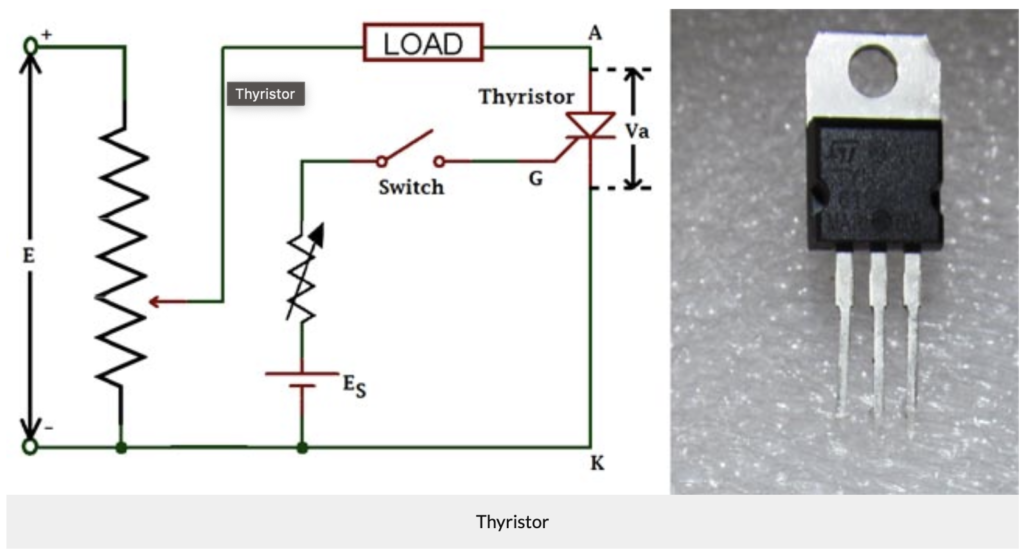Introduction:
Thyristors, often referred to as silicon-controlled rectifiers (SCRs), are semiconductor devices that play a vital role in power control and regulation. They are capable of handling high power levels and find applications in a wide range of industries.
In this detailed blog post, we will unravel the operation, types, and applications of thyristors, providing clarity on their significance in modern electronics.
Read More: 5 Reasons Why Is It So Hard to Manufacture Semiconductors? – techovedas
Understanding Thyristors:
A thyristor is a four-layer semiconductor device that conducts current only in one direction. It acts as a switch, allowing current to flow once triggered, and remains conducting until the current drops below a certain threshold.
Imagine a one-way valve in a water pipe system. Once the valve is opened (triggered), water flows through freely. It stays open until water pressure drops below a certain level, at which point the valve closes. Similarly, a thyristor conducts electrical current in one direction when triggered and remains conducting until the current decreases below a specific level.
Follow us on LinkedIn for everything around Semiconductors & AI
The Thyristor’s Evolution: A Journey Through Advancements
The evolution of thyristors is a remarkable story of innovation and progress, spanning over half a century. From their inception to the latest developments, thyristors have undergone significant transformations. Let’s embark on a journey through the key milestones in the evolution of thyristors.
Birth of the Thyristor (1957):
The journey begins with the birth of the thyristor in 1957. Scientists at General Electric (GE) developed the first silicon-controlled rectifier (SCR), laying the foundation for modern power electronics.
Introduction of GTO Thyristors (1960s):
In the 1960s, the Gate Turn-Off (GTO) thyristor emerged, introducing the concept of controlled turn-off. This innovation allowed for more precise control in high-power applications.
Triac Thyristors (1970s):
Triac thyristors, with bidirectional conductivity, became widely used in AC power control applications. They found a place in dimmer switches and lighting control systems.
Thyristors in HVDC (1980s):
During the 1980s, thyristors played a pivotal role in High-Voltage Direct Current (HVDC) transmission systems. This technology enabled efficient long-distance power transmission and grid interconnection.
Advancements in Induction Heating (1990s):
Thyristors further evolved in the 1990s, enhancing their application in induction heating systems. Precise control in processes like metal hardening and annealing became more efficient.
Thyristors in Power Electronics (2000s):
The 2000s witnessed continued advancements in thyristor technology. They played a key role in power supplies, rectifiers, and phase control circuits, further improving efficiency and reliability.
Modern Applications (Present):
Today, thyristors are integral in modern electronics, powering motor drives, regulating voltage, and controlling power in various industries. They continue to evolve, contributing to innovations in power control and electronics.
The evolution of thyristors from their humble beginnings to their current advanced state reflects their enduring significance in modern technology, enabling precise power control in diverse applications.

Image Credits: Circuit Digest
Types of Thyristors:
Thyristors, semiconductor devices crucial for power regulation, come in various types, each tailored for specific applications. Here are some prominent types:
1.Silicon-Controlled Rectifiers (SCRs)
Silicon-Controlled Rectifiers (SCRs) are semiconductor devices acting as one-way switches in electrical circuits. They conduct current only when triggered, ensuring a controlled flow of electricity.
Imagine an automated gate at a toll booth. It remains closed until a vehicle approaches. Similarly, an SCR stays non-conductive until a small triggering current is applied to its gate, allowing a larger current to flow through.
Real-Life Example: In welding machines, SCRs play a crucial role. When a welder strikes an arc, it generates a surge of electrical current. SCRs control and stabilize this surge, ensuring a consistent and precise flow of current for a controlled welding process. This prevents damage to the welding equipment and ensures a high-quality weld.
By acting as efficient current regulators, SCRs find applications in various industries, from welding to power control systems, where maintaining a stable and controlled current flow is essential.
2.Gate Turn-Off Thyristor (GTO)
The Gate Turn-Off Thyristor (GTO) is akin to a traffic signal for electrical currents. Like a traffic light allows or halts vehicles, the GTO permits or stops the flow of electricity. This unique feature distinguishes it from standard thyristors, offering controlled turn-off capability.
Imagine a drawbridge that can be raised or lowered by a designated operator. The operator controls the flow of traffic by deciding when to lift or lower the bridge. Similarly, a GTO provides an operator, in this case, a gate signal, the ability to control the flow of electrical current.
Real-Life Example: In high-speed trains, GTO thyristors play a pivotal role. When the train accelerates, GTOs manage the electrical power delivered to the traction motors.
They swiftly control the flow of energy, ensuring a smooth and efficient ride. Just as a skilled conductor guides an orchestra’s performance, GTOs orchestrate the precise distribution of electrical power, enhancing the performance of high-speed rail systems.
3.Triac Thyristor:
A Triac, a subset of thyristors, is like a versatile traffic cop in the world of power electronics. This bidirectional semiconductor switch not only conducts traffic (current) in both directions but also does so with precise control.
Imagine a junction in a bustling city where traffic flows in multiple directions. The Triac functions as a traffic signal. When triggered, it allows traffic to move smoothly in both directions, and just like a dimmer switch, it can regulate the flow, easing or slowing down the traffic, or in this case, the current.
Real-Life Example: Triacs are the key components in light dimmer switches found in homes and offices. By turning the dimmer knob, you effectively control the Triac’s triggering, adjusting the amount of power supplied to the light source. This simple yet effective technology allows you to illuminate spaces with just the right amount of light, enhancing ambiance and conserving energy.
Triacs also play a pivotal role in various AC power control applications, such as speed control in electric fans and temperature regulation in heating elements. Their bidirectional conduction and precise control make them indispensable for a wide range of applications where alternating current needs to be efficiently managed.
4.Diode for Alternating Current (DIAC)
A DIAC (Diode for Alternating Current) is a trigger device employed in conjunction with thyristors, enhancing their functionality in AC switching applications. It functions as a bidirectional switch, conducting current in both directions.
Think of a DIAC as a turnstile at a stadium entrance that allows people to pass through in either direction. It remains non-conductive until a certain threshold voltage is applied, similar to how the turnstile locks until a ticket is scanned. Once this threshold is reached, the DIAC conducts electricity in both directions, just as the turnstile allows people to move in and out freely.
Real-Life Example: In a lamp dimmer switch, the DIAC plays a crucial role. As you adjust the dimmer, you change the triggering voltage applied to the DIAC. When this voltage threshold is reached, the DIAC conducts, triggering the thyristor to control the power supplied to the light. This process allows you to smoothly adjust the brightness of the lamp in a simple and efficient manner, all thanks to the DIAC’s bidirectional conduction properties.
Read More:Who invented Transistor, Really?? – techovedas
Thyristor Applications: Powering Diverse Industries
Thyristors, vital semiconductor devices, find extensive applications in various industries owing to their ability to regulate high-power circuits efficiently.
1. Motor Drives and Control:
Thyristors serve as the backbone of motor control systems in industries like manufacturing and transportation. They regulate the speed and torque of electric motors, ensuring precise and efficient operation. For instance, in an electric locomotive, thyristors govern the traction motors, enabling smooth acceleration and deceleration.
2. HVDC Transmission Systems:
High-Voltage Direct Current (HVDC) transmission is crucial for efficient, long-distance power delivery. Thyristors are integral in converting alternating current (AC) to direct current (DC) and vice versa in HVDC systems. This technology is utilized in large-scale power transmission projects, such as interconnecting power grids across regions.
3. Induction Heating:
Induction heating, prevalent in metalworking and material processing industries, relies on thyristors for precise control of heat generation. They regulate the power supplied to induction coils, ensuring uniform heating of metals for processes like hardening, annealing, and brazing.
4. Power Supplies and Rectifiers:
Thyristors play a crucial role in rectifying AC power to DC for various applications, including battery charging, electroplating, and DC welding. In uninterruptible power supplies (UPS), they ensure a seamless transition to battery power during electrical outages.
5. Light Dimming Circuits:
In residential and commercial settings, thyristors are used in light dimmers. By controlling the triggering angle of the thyristor, users can adjust the brightness of incandescent or LED lamps. This application enhances energy efficiency and provides customizable lighting solutions.
6. Controlled Switching in Power Electronics:
Thyristors serve as reliable switches in power electronic circuits. They are used in applications like phase control, where precise regulation of AC voltage is required, such as in heating systems and motor speed control.
Thyristors, with their versatility and efficiency in regulating high-power circuits, play a pivotal role in various industries. From powering electric locomotives to enabling efficient power transmission over long distances, thyristors continue to drive technological advancements across diverse sectors. Their applications underscore their significance in modern electronics and the critical role they play in powering our interconnected world.
Thyristor vs Transistor: Power Control Components
Thyristors and transistors are fundamental semiconductor devices, each playing distinct roles in electronic circuits. While transistors excel in signal amplification and switching applications, thyristors specialize in high-power regulation. This comparison will delve into their unique functionalities, applications, and how they complement each other in modern electronics.
Similarity Between thyristors and Transistors
Thyristors and transistors are both semiconductor devices, sharing several similarities:
- Semiconductor Material: Both devices are constructed using semiconductor materials, typically silicon, which allows for controlled electron flow.
- Three-Terminal Devices: Both thyristors and transistors are three-terminal devices, featuring a gate/base, collector, and emitter terminals. These terminals govern the flow of current through the device.
- Electronic Switching: Both can function as electronic switches, controlling the flow of electrical current in a circuit.
- Amplification Capability: While thyristors are primarily used for high-power applications, some specialized types like the PUT (Programmable Unijunction Transistor) can also perform amplification functions.
- Pivotal in Electronics: Both thyristors and transistors are integral components in modern electronics, enabling the creation of complex electronic circuits and systems.
- Voltage and Current Regulation: They are crucial in regulating voltage and current levels in electronic circuits, ensuring proper operation and protection against overloads.
- Diverse Applications: Thyristors and transistors find applications in various industries, including power electronics, telecommunications, and consumer electronics.
Although thyristors and transistors share similarities, it’s crucial to recognize their unique attributes and intended functions. Thyristors are fine-tuned for high-power applications, delivering precise power regulation. On the other hand, transistors shine in signal amplification and low-power level switching.
Difference Between thyristors and transistors
Thyristors and transistors are pivotal semiconductor devices, each with distinct characteristics and applications. This comparison aims to highlight their fundamental differences, showcasing how they excel in different aspects of electronics. Below, we’ll find a detailed breakdown of their disparities in key aspects.
| Aspect | Thyristors | Transistors |
|---|---|---|
| Conduction | Unidirectional (Current flows in one direction) | Bidirectional (Current flows in both directions) |
| Turn-On Mechanism | Triggered by a gate signal | Controlled by base current |
| Turn-Off Ability | Difficult (Requires external means for turn-off) | Easy (Can be turned off by altering base current) |
| Applications | High-power applications like motor control, HVDC | Signal amplification, switching in low-power apps |
| Power Handling | Excellent at handling high power | Typically used in low to medium power circuits |
| Efficiency | Efficient for high-power applications | Ideal for low-power circuits |
| Speed | Slower switching speed compared to transistors | Faster switching times |
| Heat Dissipation | More heat generated due to unidirectional conduction | Less heat generation due to bidirectional flow |
| Examples | Silicon-Controlled Rectifier (SCR), GTO, Triac | Bipolar Junction Transistor (BJT), FET |
This comparison illustrates how thyristors and transistors cater to different electronic needs, from high-power regulation to low-power signal processing. Understanding their unique characteristics is crucial in selecting the right component for a given application.
How Do They Work?
Thyristors, also known as silicon-controlled rectifiers (SCRs), are semiconductor devices that control the flow of electric current in a circuit. They operate on the principle of positive feedback, which means once triggered, they remain in the conducting state until the current falls below a certain threshold.
Here’s a step-by-step explanation of how a thyristor works:
- Off State (Blocking State): In the off state, the thyristor acts as an open switch, blocking the flow of current. This is because the voltage applied across the anode and cathode terminals is not sufficient to trigger the thyristor.
- Gate Triggering: When a small current, known as the gate current, is applied to the gate terminal of the thyristor, it reaches a critical level. This triggers a process called “latching,” causing the thyristor to transition into the on state.
- Turn-On (Conduction) State: Once triggered, the thyristor conducts current freely from the anode to the cathode. This state persists even after the gate current is removed, thanks to positive feedback.
- Holding Current: While in the on state, the current flowing through the thyristor must be maintained above a certain threshold known as the holding current. If the current falls below this level, the thyristor will turn off.
- Turn-Off (Blocking) State: To turn off the thyristor, the current through it must be reduced to zero. This can happen naturally if the load’s current drops to zero, or through an external means like a commutation circuit.
- Commuation (Optional):In high-power applications, engineers may utilize external circuitry to assist in deactivating the thyristor. This procedure, referred to as commutation, entails diverting the current away from the thyristor.
It’s important to emphasize that once a thyristor triggers, it continues to conduct until either the current passing through it drops below the holding current or an external method actively switches it off.
This behavior makes thyristors particularly useful in applications where they need to handle high-power loads and maintain a steady state of conduction. They are widely used in areas like motor control, power regulation, and high-voltage transmission systems.
Advantages of Thyristors:
- High Power Handling: Thyristors can handle high current and voltage levels, making them suitable for power-intensive applications.
- Reliability: Once triggered, a thyristor remains conducting until the current drops below a specific threshold, ensuring stability in various applications.
- Efficiency: Thyristors have high switching efficiencies, minimizing power losses in control circuits.
Conclusion:
Thyristors are indispensable components in power control and regulation, finding applications in diverse industries. Their ability to handle high power levels and provide precise control makes them pivotal in modern electronics. By understanding the operation and types of thyristors, engineers and designers can leverage their capabilities to create efficient and reliable electronic circuits for a wide range of applications.







